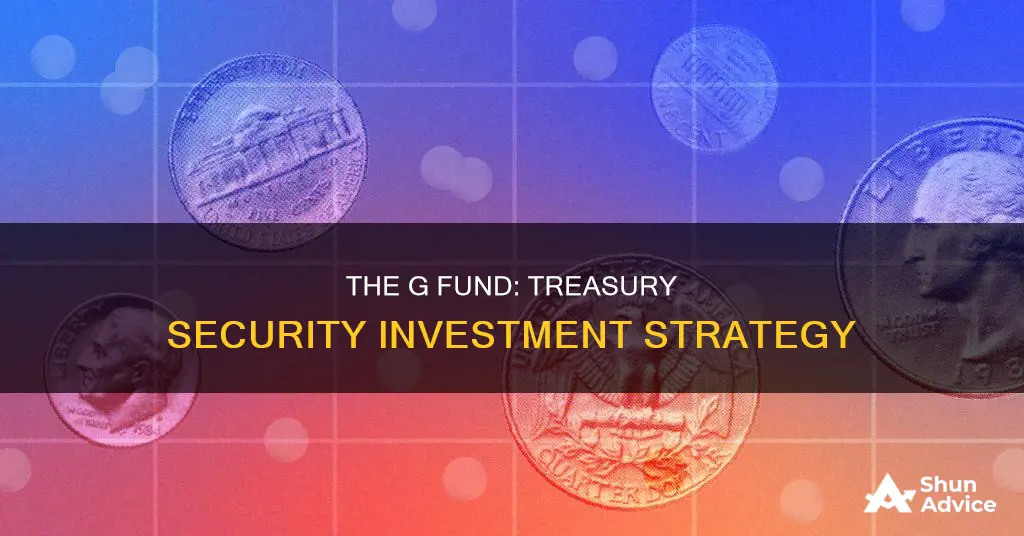
The Thrift Savings Plan (TSP) is a retirement investment program offered to US federal employees and uniformed services members. The TSP G Fund, or Government Securities Investment Fund, is one of five funds available to TSP participants. The G Fund invests in short-term, non-marketable US Treasury securities, which are guaranteed by the federal government. The fund is designed to preserve capital and protect investors from loss, making it ideal for those nearing retirement. While the G Fund has historically provided the lowest rate of return among the TSP funds, it offers stability and a virtually risk-free investment option.
| Characteristics | Values |
|---|---|
| Name | Thrift Savings Plan (TSP) G Fund |
| Other Names | Government Securities Investment Fund |
| Type of Fund | Low volatility, virtually risk-free US bond fund |
| Investment Type | Non-marketable US Treasury securities |
| Purpose | Preserve capital and keep investors safe so that no money is lost |
| Interest Rate | Set and recalculated every month to the average rate of return of US Treasury securities with 4 or more years to maturity |
| Returns | 4.2% since August 1990; 8% in the late 1980s to early 1990s; declined since 2010 due to low inflation and interest rates |
| Suitability | Investors nearing retirement who want to protect their savings from loss; conservative investors |
What You'll Learn

The G Fund is a low-volatility, virtually risk-free US bond fund
The Thrift Savings Plan (TSP) is a retirement investment program offered exclusively to federal employees and members of the uniformed services. The G Fund is one of the five core funds available to TSP participants.
The G Fund is intended for conservative investors who want to protect their retirement savings from loss. It is designed to preserve capital and generate returns above those of short-term US Treasury securities. The interest paid by the G Fund is set to the average rate of return of US Treasury securities with 4 or more years to maturity, and it is recalculated every month. This means that TSP investors get a higher interest rate than they would from a typical safe investment like US T-Bills or a money market fund.
Historically, the G Fund has provided a good deal for investors. From its inception in August 1990 until 2010, the G Fund outpaced 3-month US Treasury Bills, and it managed to outperform inflation by a significant margin. However, since 2020, the G Fund has not kept pace with inflation due to historically low interest rates.
The G Fund is also unique among the TSP funds in that it does not invest in an index. Instead, it invests in a special non-marketable treasury security issued specifically for the TSP by the US government. This means that the G Fund is not tradeable outside of the TSP, and it receives very little coverage in the popular media.
Investing Beyond Mutual Funds: Exploring Alternative Investment Avenues
You may want to see also

It's the only TSP fund that guarantees a return on the principal
The Thrift Savings Plan (TSP) is a retirement investment program offered to US federal employees and uniformed services members. It functions similarly to a 401(k) plan, allowing employees to contribute part of their pay to their retirement account while receiving a match from their employer.
The TSP G Fund, or Government Securities Investment Fund, is one of five funds available to TSP participants. It is the only TSP fund that guarantees a return on the principal. This means that investors are assured they will receive the required payments, and their money is protected from loss. The fund is backed by the full faith of the US government, which guarantees the payment of the G-Fund principal and interest.
The G Fund is invested in short-term, non-marketable US Treasury securities that are issued specifically for the TSP. These securities are considered very low-risk and low-yield, making the G Fund ideal for conservative investors. The interest paid by the G Fund is set to the average rate of return of US Treasury securities with four or more years until maturity, and this rate is recalculated each month.
Historically, the G Fund has provided a relatively stable return, with a compound annualised return of 4.2% since August 1990. However, due to low inflation and interest rates, the G Fund has not outpaced inflation since 2020.
The G Fund is intended for investors who prioritise capital preservation over long-term growth and are seeking a safe investment option for their retirement savings. It is particularly suitable for those nearing retirement who want to protect their savings from loss.
Investing in Ultra-Short Mutual Funds: Recession-Proof Strategy?
You may want to see also

The G Fund is invested in short-term US Treasury securities
The G Fund is a low-volatility, virtually risk-free US bond fund. It is invested in short-term US Treasury securities that are specially issued to the Thrift Savings Plan (TSP).
The G Fund is the only TSP fund that does not invest in an index. Instead, it invests in a special non-marketable treasury security issued by the US government specifically for the TSP. This means that G Fund securities are not tradeable outside of the TSP.
The G Fund is intended for very conservative investors and is designed to protect investors from loss. It is backed by the full faith of the US government, which guarantees the payment of the principal and interest. As such, the G Fund is the only TSP fund that guarantees the return of the investor's principal.
The interest paid by the G Fund is set to the average rate of return of US Treasury securities with four or more years to maturity. This interest rate is recalculated every month. While the G Fund itself is invested in short-term securities, TSP investors benefit from a higher interest rate. This is because the interest rate on longer-term Treasury securities is usually higher than that of short-term notes.
The G Fund has historically provided the lowest rate of return compared to the other TSP funds. However, it has also provided stability and preservation of capital, which is particularly attractive to investors nearing retirement.
Index Funds vs. IRAs: Where Should You Invest?
You may want to see also

The G Fund's interest rate is adjusted each month
The G Fund is a low-volatility, virtually risk-free US bond fund that is a part of the Thrift Savings Plan (TSP) offered to US government employees. The G Fund interest rate is adjusted each month. This is because the interest paid by the G Fund is set to the average rate of return of US Treasury securities with four or more years to maturity, which is recalculated every month.
The G Fund is invested in short-term US Treasury securities that are specially issued to the TSP. The Treasury Department calculates the G Fund interest rate as the weighted average yield of approximately 183 US Treasury securities on the last day of the previous month. This means that while the G Fund itself is invested in short-term securities, TSP investors get a higher interest rate.
The G Fund interest rate is not designed to match the rate of inflation. Therefore, the biggest risk of the G Fund is that an investor will lose purchasing power over time as the interest rate may not keep up with inflation. For example, in July 2023, when inflation started to heat up, the G Fund returns were about 2.31%. After inflation impacted the interest rate being paid by Treasury securities, the rate increased to 3.84%.
The G Fund has historically provided the lowest rate of return compared to the other core funds in the TSP. However, it is also the lowest-risk fund, intended for very conservative investors.
Mutual Funds and Investment Trusts: What's the Difference?
You may want to see also

The G Fund has historically provided the lowest rate of return
The G Fund is the Government Securities Investment Fund, one of the five funds available to Thrift Savings Plan (TSP) participants. It is a low-volatility, virtually risk-free US bond fund. The G Fund has historically provided the lowest rate of return of any of the core funds. This is because it is invested in very low-risk, low-yield government bonds. The G Fund is intended for very conservative investors.
The G Fund is invested in short-term US Treasury securities that are specially issued to the TSP. The interest paid by the G Fund is set to the average rate of return of US Treasury securities with four or more years to maturity. This is recalculated every month. The G Fund's interest rate is adjusted each month, but it is not designed to match the rate of inflation. The biggest risk of the G Fund is that an investor will lose purchasing power over time as the rate may not keep up with inflation.
The G Fund has been successful in meeting its objective of preserving capital and generating returns above those of short-term US Treasury securities throughout the life of the TSP. The G Fund has earned a compound annualised return of 4.2% since August 1990. If you look back to the 1980s, when interest rates were higher, the G Fund return was almost 9%. However, since 2010, the rate of return has steadily declined due to a combination of historically lower inflation and interest rates.
The G Fund is ideal for those nearing retirement who want to protect their retirement savings from loss. However, if you are interested in long-term growth and do not need to preserve your capital, and you have a long time before you reach retirement age, a G-fund may not be the best option.
Mutual Fund Investment: Choosing the Right One
You may want to see also
Frequently asked questions
The TSP G Fund is the Government Securities Investment Fund, one of the five funds available to TSP participants.
The TSP G Fund invests in short-term, non-marketable US Treasury securities that are issued specifically for the TSP.
The objective of the TSP G Fund is to preserve capital and generate returns above those of short-term US Treasury securities.
The TSP G Fund is the only fund in the TSP that guarantees the return of the investor's principal, i.e., it is a low-volatility, virtually risk-free fund.
The TSP G Fund has historically provided the lowest rate of return of any of the core funds. However, between its inception and 2010, it managed to outperform inflation by a significant margin.







